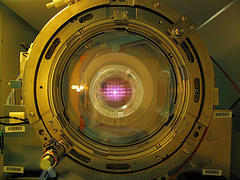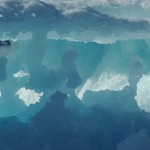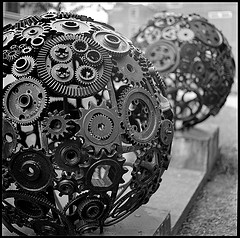helping you to navigate SciEng information
October 1st, 2009 by Eugene Barsky | No Comments »
Those of us, who teach or use Google or Google Scholar (GS) might find the most recent Peter Jacso’s piece on Google Scholar to be of interest – http://www.libraryjournal.com/article/CA6698580.html?&rid=1105906703&source=title
Please be very careful using this tool. We talk about the perils of GS and compare it with Compendex and Web of Science in our Google workshops.
We ourselves saw those problems almost five years ago, and they are still not corrected:
Giustini D, & Barsky E. A look at Google Scholar, PubMed and Scirus: comparisons and recommendations . J Can Health Libr Assoc 2005, 26(3): 85-89.
Posted in Astronomy, Atmospheric Science, Chemical and Biological Engineering, Chemistry, Civil Engineering, Earth and Ocean Sciences, General Science, Geography, Main, Materials Engineering, Mathematics, Mechanical Engineering, Mining engineering, Physics, Science - undegraduate classes, Statistics, Teaching, Wood Sciences | No Comments »
September 25th, 2009 by Kevin Lindstrom | No Comments »
This week’s issue of Science focuses in CO2 capture and storage.
Articles include
Why Capture CO2 from the Atmosphere?
Round and Round: A Guide to the Carbon Cycle
Onshore Geologic Storage of CO2
Submitted by Kevin Lindstrom Liaison Librarian for Earth and Ocean Sciences
Posted in Atmospheric Science, Chemical and Biological Engineering, Chemistry, Civil Engineering, Earth and Ocean Sciences, General Science, Geography, Mining engineering, Science - undegraduate classes, Uncategorized | No Comments »
July 8th, 2009 by Eugene Barsky | No Comments »

Yesterday’s article in NYT fascinated me with its title – “As Unbreakable as … Glass?”
There is lots of research in this area that you can find in Web of Science database, Compendex database, and of course in the standard-bearer for anything chemical – SciFinder Scholar database.
We also own hundreds of books on this topic. Here is the short list for Glass.
** photo by smb
Posted in Amusing stuff, Chemical and Biological Engineering, Chemistry, Civil Engineering, Main, Materials Engineering, Science - undegraduate classes | No Comments »
July 3rd, 2009 by Eugene Barsky | No Comments »

A very recent article on PLoS One is worth the read –
Bollen J, Van de Sompel H, Hagberg A, Chute R, 2009 A Principal Component Analysis of 39 Scientific Impact Measures. PLoS ONE 4(6): e6022. doi:10.1371/journal.pone.0006022
Abstract:
Background
The impact of scientific publications has traditionally been expressed in terms of citation counts. However, scientific activity has moved online over the past decade. To better capture scientific impact in the digital era, a variety of new impact measures has been proposed on the basis of social network analysis and usage log data. Here we investigate how these new measures relate to each other, and how accurately and completely they express scientific impact.
Methodology
We performed a principal component analysis of the rankings produced by 39 existing and proposed measures of scholarly impact that were calculated on the basis of both citation and usage log data.
Conclusions
Our results indicate that the notion of scientific impact is a multi-dimensional construct that can not be adequately measured by any single indicator, although some measures are more suitable than others. The commonly used citation Impact Factor is not positioned at the core of this construct, but at its periphery, and should thus be used with caution.
Frankly, I was surprised by the authors’ conclusion, particularly with this piece: “Our results indicate that the JIF and SJR express a rather particular aspect of scientific impact that may not be at the core of the notion of scientific “impact”. Usage-based measures such as Usage Closeness centrality may in fact be better “consensus” measures.”
I am used to be inquired about Journal Impact Factor (JIF) so often in academia and know that it used for tenure consideration in many departments in UBC.
** photo by testone 22
Posted in Astronomy, Atmospheric Science, Chemical and Biological Engineering, Chemistry, Civil Engineering, Earth and Ocean Sciences, General Science, Geography, Main, Materials Engineering, Mathematics, Mechanical Engineering, Physics, Podcasts, Science - undegraduate classes, Statistics, Wood Sciences | No Comments »
June 29th, 2009 by Aleteia Greenwood | No Comments »

UBC Engineering student helps collect scientific data for Canada’s Arctic submission to the United Nations
Alexander Forrest, a UBC civil engineering PhD candidate, is part of a team supporting the use of autonomous underwater vehicles (AUVs) to collect scientific data for Canada’s Arctic submission to the United Nations.
Forrest has been working with International Submarine Engineering Ltd. as a support engineer and will assist in AUV operations next year when two AUVs operate thousands of metres under the ice to survey the seabed.
Canada, the U.S., and Denmark are collecting scientific data to establish sovereign rights to parts of the Arctic Ocean under the United Nations Convention on the Law of the Sea. Canada has until 2013 to provide its submission to the United Nations. Russia and Norway have already made submissions to the UN.
More at UBC This Week.
**image by cam17
Posted in Civil Engineering, General Science, Geography, Main, Uncategorized | No Comments »
June 9th, 2009 by Eugene Barsky | No Comments »

Thomson Reuters has released its latest figures for Canadian Science last week – http://sciencewatch.com/dr/sci/09/may31-09_2/
Between 2004 and 2008, Thomson Reuters indexed 226,232 papers that listed at least one author address in Canada. Of those papers, the highest percentage appeared in journals classified under the heading of environment/ecology, followed by psychiatry/psychology and geosciences. As the right-hand column shows, the citations-per-paper average for environment/ecology papers from Canada-based authors was 24% above the world average in the field (5.49 cites per paper for Canada versus 4.43 cites for the world). In fact, in all the fields shown here, the impact of Canadian research exceeded the world average, with particularly strong performance in space science (44% above the world average), physics (43% above), and agricultural sciences (+29%).
It is great to see that we are producing a decent share of world’s research. But it seems that Engineering is one of weak points!
** Photo by tripleman
Posted in Astronomy, Atmospheric Science, Chemical and Biological Engineering, Chemistry, Civil Engineering, Earth and Ocean Sciences, General Science, Geography, Main, Materials Engineering, Mathematics, Mechanical Engineering, News, Physics, Science - undegraduate classes, Statistics, Wood Sciences | No Comments »
May 27th, 2009 by Eugene Barsky | No Comments »

Thomson Reuters’ owned ScienceWatch.com has recently released the figures for “Top 20 Countries in Engineering“.
…is a listing of the top 20 countries which, as of the latest bimonthly update of Essential Science IndicatorsSM, attracted the highest total citations to their papers published in Thomson Reuters-indexed journals of Engineering over an 11-year period, (1998-December 31, 2008). These countries are of a pool of 96 countries comprising the top 50% ranked by total citation count in this field.
It is great to see Canada as #7 with 4.39 citations per paper!
** Photo by tim_d
Posted in Chemical and Biological Engineering, Civil Engineering, General Science, Main, Materials Engineering, Mechanical Engineering, News, Science - undegraduate classes | No Comments »
May 8th, 2009 by Kevin Lindstrom | No Comments »
Statistics isn’t just about bayesian disease mapping and analyzing incomplete multivariate data. Statistics has some very important applications for analyzing hockey – yes, ice hockey. While my team hasn’t made the playoffs for a while except for that glorious 2006 run, it might be interesting to for any of you hockey statisticians to apply the research to the teams currently playing in the NHL playoffs.
Here’s a sample of some the articles available in MathSciNet and Current Index to Statistics dealing with ice hockey.
Thomas, Andrew C. (2007) “Inter-arrival Times of Goals in Ice Hockey,” Journal of Quantitative Analysis in Sports: Volume 3: Issue 3, Article 5. Available at: http://www.bepress.com/jqas/vol3/iss3/5
Thomas, Andrew C. (2006) “The Impact of Puck Possession and Location on Ice Hockey Strategy,” Journal of Quantitative Analysis in Sports: Volume 2: Issue 1, Article 6. Available at: http://www.bepress.com/jqas/vol2/iss1/6
Anthology of Statistics in Sports. Edited by Jim Albert, Jay Bennett and James J. Cochran. ASA-SIAM Series on Statistics and Applied Probability, 16. 2005.
Gill, Paramjit S. (2000) “Late-Game Reversals in Professional Basketball, Football, and Hockey” The American Statistician, Volume 54, Number 2 (May, 2000), pp. 94-99 http://www.jstor.org/stable/2686024
The Journal of Quantitative Analysis in Sports is a great place to browse.
Submitted by Kevin Lindstrom UBC Science and Engineering Librarian
Posted in Amusing stuff, Atmospheric Science, Chemical and Biological Engineering, Chemistry, Civil Engineering, Earth and Ocean Sciences, General Science, Geography, Main, Materials Engineering, Mathematics, Mechanical Engineering, News, Physics, Podcasts, Science - undegraduate classes, Statistics, Uncategorized, Wood Sciences | No Comments »
April 24th, 2009 by Kevin Lindstrom | No Comments »
Canada Excellence Research Chairs – Phase 1 Competition Results
Overview
In 2008, the Government of Canada created a new permanent program to establish 20 prestigious research chairs–Canada Excellence Research Chairs (CERC)–in universities across the country. The CERC program invests $28 million a year to attract and retain the world’s most accomplished and promising minds and help Canada build a critical mass of expertise in the priority research areas of environmental sciences and technologies, natural resources and energy, health and related life sciences and technologies, and information and communication technologies.
Phase 1 Competition Results
The following 17 universities have been invited to compete in Phase 2.
Universities invited to Phase 2 competition
(Number of successful proposals arranged from West to East)
* University of British Columbia (4)
* University of Alberta (5)
* University of Calgary (1)
* University of Saskatchewan (1)
* University of Manitoba (1)
* University of Toronto (5)
* University of Waterloo (4)
* McMaster University (2)
* Queen’s University (1)
* University of Western Ontario (2)
* University of Ottawa (2)
* McGill University (4)
* Université Laval (3)
* Université de Sherbrooke (1)
* Université du Québec à Trois-Rivières (1)
* University of Prince Edward Island (1)
* Dalhousie University (2)
Click here for a list of the successful proposals
Submitted by Kevin Lindstrom Liaison Librarian
Posted in About this blog, Amusing stuff, Atmospheric Science, Chemical and Biological Engineering, Chemistry, Civil Engineering, Earth and Ocean Sciences, General Science, Geography, Main, Materials Engineering, Mathematics, Mechanical Engineering, News, Physics, Podcasts, Science - undegraduate classes, Statistics, Teaching, Uncategorized, Wood Sciences | No Comments »
April 17th, 2009 by Kevin Lindstrom | No Comments »
Giving the green light for BC small hydro: independent power producers are taking up the challenge to develop British Columbia’s plentiful supplies of small hydro. Suzanne Pritchard reports. International Water Power & Dam Construction, Dec 2008 v60 i12 p40(2)
“Well known for its mountainous topography and abundant rainfall, the coastal regions of British Columbia can have more than 4m of rainfall per year. In addition, the province’s sheer size, run-off from snow melt and thousands of creek reaches mean it is also ideally suited for run-of-river hydro power. ‘There is phenomenal potential for small hydro here,’ says Mike Wise, vice chair of the hydro committee for the Independent Power Producers Association of British Columbia (IPPBC). ‘The hydro sites are just fantastic.'”
“Beyond British Columbia’s ideal geographic setting for hydro power is the unique ‘green’ design of the run-of-river projects. ‘This design is very different to hydro projects almost anywhere in the world. It is the sole reason why we are judged to have the lowest environmental impact,’ says Steve Davis, president of the IPPBC.
“‘We do not have big storage reservoirs,’ says Davis. ‘In fact, typical headpond is only the size of a soccer field. While most others have short, thick pipes in tall concrete dams, our projects have long, narrow steep pipes and low rubber weirs. Our glaciated hanging valleys and alpine lakes enable us to locate the projects above a natural fish barrier and still get lots of head. So unlike most other hydro projects we are able to avoid directly impacting fish habitat.'”
Want to be familiarize yourself with run of river research both in terms of both the environmental and engineering aspects? What are the issues? Want to separate the hype from the reality?
The following databases will gave you access to international research dealing with run of river power generation:
ASFA and Geobase will give you access to environmental and fisheries related research. Compendex is excellent for the engineering side of run of river power generation.
Submitted by Kevin Lindstrom Liaison Librarian for Earth and Ocean Sciences
Posted in Civil Engineering, Earth and Ocean Sciences, General Science, Geography, Main, Science - undegraduate classes, Uncategorized | No Comments »
« Newer Posts - Older Posts »





